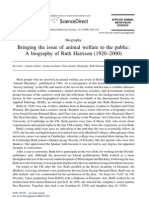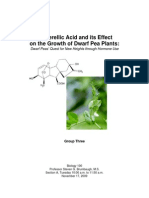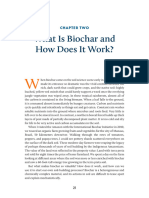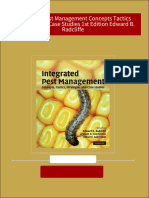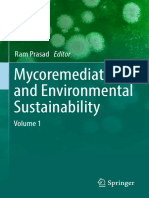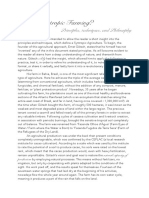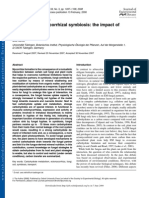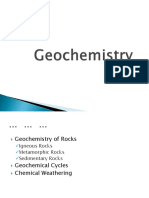Waksman On Justus Von Liebig Humus Theory
Waksman On Justus Von Liebig Humus Theory
Uploaded by
ajúnior_13Copyright:
Available Formats
Waksman On Justus Von Liebig Humus Theory
Waksman On Justus Von Liebig Humus Theory
Uploaded by
ajúnior_13Original Description:
Original Title
Copyright
Available Formats
Share this document
Did you find this document useful?
Is this content inappropriate?
Copyright:
Available Formats
Waksman On Justus Von Liebig Humus Theory
Waksman On Justus Von Liebig Humus Theory
Uploaded by
ajúnior_13Copyright:
Available Formats
LIEBIGTHE HUMUS THEORY AND THE ROLE
OF HUMUS IN PLANT NUTRITION*
By SELMAN A. WAKSMAN
NEW JERSEY AGRICULTURAL EXPERIMENT STATION, NEW S R U N S W I C K , N . J .
^Z A rational system of agriculture cannot 6e
formed without the application of scientific principles; for such a system must he based 07i an exact
acquaintance with the means of nutrition of vegetables, and with the influence of soils and action
of manure upon them.
concerning the chemical composition of
plants, as well as from the study of the
gaseous exchange between plants and the
atmosphere. This was largely due to the
work of a group of chemists and plant
JUSTUS LIEBIQ.
physiologists, during the latter part of the
18th and early 19th centuries, who estabI T has been recognized since ancient lished the fact that plants have a complitimes that crops grown continuously in the cated physiology, that some of the nutrients
same field roh the soil of its fertility. I t are obtained by the plants from the atmoswas also known that certain treatments
phere and some from the soil, and that sunsuch as the addition of animal manures
light plays a significant role in plant life.
and green manures, as well as lime, greatly
Two distinct theories were gradually
improve soil fertility, though lime may
evolved. One, the humus theory, was supprove injurious when used in excess. The
plant nutrients were believed by the nat- ported chiefly by certain agronomists and
ural philosophers to exist in the soil in a plant physiologists, as well as by many
state required by the plants for their direct chemists. The other was the more strictly
nutrition, without any specific metabolism. chemical theory of plant nutrition, based
upon the investigations of Priestley, IngenEven as late as the early part of the 19th
Housz, Senebier and de Saussure.
*
^
century, there was still considerable confuThe humus theory was an outgrowth of
sion pertaining to the nutrition of plants,
the older conception of the role of " e a r t h "
and the part played by the soil and air
in plant nutrition, supplemented by the
constituents. The earlier conception that
accumulating evidence concerning the fawater, earth and air, or all three combined,
vorable
effect of animal manures and
are the major direct nutrients ("principal
plant
residues
upon crop production. This
nourishments") of plants still prevailed;
theory
found
particular
expression in the
in some eases, fire and nitre were also inwork
of
Wallerius
(1761),
in the middle of
cluded as nutrients. Soil humus or some
the
J8th
century,
and
of
Thaer (1809substance present in it was considered to be
1812)
in
the
early
part
of
the
19th. It was
an important, if not the important, "principle." In some cases it was recognized also accepted by such brilliant chemists as
that other substances, such as lime or cer- Berzelius and Sir Humphrey Davy (1813).
tain salts, besides humus may play a part According to this theory, plants feed upon
in plant nutrition; however, these were be- substances which are similar to them in
lieved to be merely supplementary ("in- nature. The organic matter of the soil, or
strumentalia") in distinction from the the soil humus, was regarded as the chief
major nutrient function of humus itself nutrient for plants and the major source of
soil fertility. The roots of the plants were
("nutritiva").
believed to extract the humus from the soil
Notable progress had been made, howand to transform it into plant substance,
ever, as a result of accumulating evidence
by combining it with water. Plant nutri* Journal Series paper. New Jersey Agricultural
Experiment Station, Eutgers University, Depart- tion was thus considered as similar to animal nutrition, both plants and animals
ment of Soil Chemistry and Microbiology.
56
HUMUS THEORY AND HUMUS IN PLANT NUTRITION
feeding upon complex organic bodies. As
regards the function of minerals in plants,
some of the protagonists of the humus
theory believed that these were not essential for growth; they were believed to act
as stimulants rather than as nutrients.
Others looked upon the minerals as mere
accidental plant constituents, or as the
skeleton substances of plants similar to the
bones of animals. Still others, especially
the vitalists, actually suggested that the
minerals are synthesized by plants as a
result of their vital forces. The last concept received the full scorn of Davy (1821),
who compared it to the "sublime generalization of the ancients that matter is the
same in essence, and that difEerent substances, considered as elements by chemists, are merely different arrangements of
the same indestructible particles.''
Agronomists and plant physiologists, for
the most part, were firmly convinced that
humus represented the carbon source for
I^ants. Thaer, for example, stated quite
emphatically that " t h e fertility of the soil
depends entirely on humus, since, besides
water, it alone furnishes in the soil nutrients to plants. Without it no individual
life is possible. Mineral fertilizers which
do not contain any organic matter, act
largely or entirely through the decomposition processes which they stimulate." The
influence of Thaer and his fellow agronomists upon practical agriculture was so
great that one landowner wrote to him (as
cited by Liebig in his Natural Laws of
Husbandry, 1863): " I f I receive a letter
from you this evening to fire my buildings,
before night they shall be in flames."
As opposed to these ideas of the function
of humus in plant nutrition, there began to
accumulate considerable information which
pointed to the true importance of leaves
and roots. Emphasis was thereby laid
upon the role of carbon dioxide, in plant
nutrition.
Priestley (1790) observed that plants
purify the air; he found that the alga
Conferva gave off oxygen in water impregnated with carbon dioxide in the sunlight
but not in darkness. This led him to em-
57
phasize that "plants, instead of affecting
the air in the same manner as animal
respiration, reverse the effects of breathing, and tend to keep the atmosphere sweet
and wholesome." Priestley did not recognize the great significance of the results of
his experiment. Ingen-Housz (1779,1796),
confirmed his observations; but also discovered that plants give off carbon dioxide
in darkness. However, he also failed to
draw the correct conclusions since he could
not free himself from the idea of the transmutation faculty of plants, which were believed capable of transmuting oxygen into
carbon dioxide, in a manner similar to the
supposed capacity of animals to transform
vegetable acids into phosphoric acid.
I t was Senebier (1782, 1783) who first
proved that the oxygen evolved by green
plants is proportional to the amount of
carbon dioxide present, up to the point
where an excess of CO2 begins to injure
the plants. Senebier recognized the important role that carbon dioxide plays as a
source of carbon for plants. The function
of humus in the soil was believed to consist
in the liberation of carbon dioxide, which
was thus made available to the plant roots
and leaves. These investigations were further extended by de Saussure (1804), who
established beyond doubt that green plants
assimilate the carbon from the carbon dioxide of the atmosphere; light is used as a
source of energy and oxygen is liberated;
the organic matter in the plants is synthesized from the carbon dioxide and water.
The soil was believed to furnish a small, but
essential, part of the plant nutrients, including the nitrogen and the mineral constituents; the roots of the plants exercise
only a selective action in absorbing different salts from the soil. The fertilizing
value of humus was believed to be due
chiefly to its mineral constituents.
Unfortunately, these investigations, however brilliant and convincing, were not
sufficient to dispose of the humus theory.
Even de Saussure himself still believed
that, in addition to carbon dioxide, plants
can also utilize humus as a source of carbon. Further, the role of the mineral ele-
58
LIEBIG AND AFTER LIEBIG
ments in plant nutrition was not sufficiently appreciated, although it became
generally recognized that plants obtain
their minerals directly from the soil. This
was clearly outlined by Sprengel (1838)
two years before the publication of Liebig 's
book. He stated:
The conviction should have been reached long ago
that humus is not such an important substance as
we have been led to believe and that the current
doctrine of humus is exceedingly full of contradictions. The old view, however, continues to be
firmly retained, for we see daily how it has been
copied from older into later works and even into
the latest,a circumstance of much convenience for
agricultural writers but one that does not advance
science or practice a single step. I t is in fact most
remarkable that a doctrine, so senseless and false
in its conclusions, should have been and should be
so continually maintained and that it did not long
ago collapse like a building on shaky foundations.
The situation may be explained by considering first
how erroneous are the present conceptions of plant
nutrition and secondly how extremely defective
were the experiments upon which the old doctrine
was based. We are therefore not at all justified
in continuing to maintain as uncontrovertible truth
what has been asserted for the past 25 years. I t
would be superfluous for me to repeat what I have
already written upon this subject in my Chemistry
and Treatise on Fertilizers. I will only state that
I am more than ever convinced of the correctness
of my previously expressed views and that, although regarding humus as a very important soil
constituent, I have come more and more to the
conviction that plants can entirely dispense with it.
The lucid ideas of Sprengel and the brilliant contributions of de Saussure remained
largely of theoretical significance and had
only a limited influence upon agricultural
practice. However, the ground was firmly
laid for a systematic study of the problem
of plant nutrition, and for the application
of this information to the furthering of
agriculture and of crop production. This
task was undertaken, on the one hand, by
Boussingault in France, followed by Lawes
and Gilbert in England, who initiated the
experimental method of studying the effects
of different fertilizing elements upon plant
growth, and, on the other hand, by Liebig
in Germany, who by his clear vision recognized that the time was ripe not only to
dispose of the humus theory, but also to
. improve agricultural practice. In develop-
ing the concept of soil fertility, Liebig
(1840) stated quite emphatically:
The fertility of every soil is generally supposed
by vegetable physiologists to depend on the presence in it of a peculiar substance to which they
have given the name of humus.
This substance,
believed to be the principal nutriment of plants,
and to be extracted by them from the soil in which
they grow, is itself the product of the decay of
other plants (p. 4 ) .
Chemists have been in the habit of designating
all products of the decomposition of organic bodies
which had a brown or brownish-black colour by the
names of humio acid or humin, according as they
were soluble or insoluble in alkalies; although in
their composition and mode of origin, the substances thus confounded might be in no way allied.
Not the slightest ground exists for the belief
that one or other of these artificial products of the
decomposition of vegetable matters exists in nature
in the form and endowed with the properties of
the vegetable constituents of mould; there is not
the shadow of a proof that one of them exerts any
influence on the growth of plants either in the way
of nourishment or otherwise (pp. 6-7).
He emphasized further:
Vegetable physiologists have, without any apparent reason, imputed the known properties of the
humus and humic acids of chemists to that con- .
stituent of mould which has received the same
name, and in this way have been led to their theoretical notions respecting the functions of th,R latter
substance in vegetation.
The opinion that the substance called humus is
extracted from the soil by the roots of plants, and
that the carbon entering into its composition serves
in some form or other to nourish their tissues, is so
general and so firmly established, that hitherto any
new argument in its favour has been considered
unnecessary; the obvious difference in the growth
of plants according to the known abundance or
scarcity of humus in the soil, seemed to afford
incontestable proof of its correctness.
Yet, this position, when submitted to a strict
examination, is found to be untenable, and it becomes evident from most conclusive proofs that
humus in the form in which it exists in the soU
does not yield the smallest nourishment to plants
(p. 7).
Humus was looked upon by Liebig as
organic matter in a state of decomposition. .When coming in contact with the air, it
undergoes slow but gradual oxidation, thus
serving as a source of carbon dioxide for
young plants, before they have developed
sufficiently to be able to utilize the gas from
the atmosphere. The oxidation of humus
HUMUS THEORY AND HUMUS IN PLANT NUTRITION
was also believed to lead to the liberation
of the minerals, thus rendering them again
available for plant nutrition; the carbon
dioxide produced contributed to the process
of making the minerals more readily available for plant growth. Humus was thus
considered not as a direct nutrient of
plants but as a connecting link between two
generations of plants, and between dead
and living matter. Liebig (1840) realized
that,
In attempting to explain the origin of carbon in
plants, it has never been considered that the question is intimately connected with that of the origin
of humus. I t is universally admitted that humus
arises from the decay of plants. No primitive
humus, therefore, can have existed; for plants must
have preceded the humus (p. 16).
The great chemist Lavoisier, as quoted by
Pasteur (1839), stated more than half a
century earlier that,'
Plants derive the materials necessary for their
formation from the air which surrounds them, from
the water, and in general from the mineral kingdom. Animals feed on plants, or other animals fed
by plants, so that the substances composing them
are, in the last instance, always drawn from air
and from the mineral kingdom. On the other hand,
fermentation, putrefaction, and combustion continually restore to the air and the mineral kingdom
the principles borrowed from them by plants and
animals.
Liebig enlarged upon this concept by emphasizing that plants live upon carbonic
acid gas, ammonia, water, phosphoric acid,
sulphuric acid, silicic acid, lime, magnesia,
potash, and iron; many of them also require
common salt. The action of manure or the
excrement of the lower animals and man
was believed to take place not as a result
of the direct assimilation of its organic elements by plants, but indirectly through the
products of its decomposition. The carbon
is transformed into carbonic acid gas, the
nitrogen into ammonia or nitric acid. He
further stated that organic manure, which
consists of the residues of plants and animals, can be replaced by its inorganic constituents into which it breaks down when
placed in the soil.
It is of particular interest to dwell fur-
59
ther upon Liebig's concept of decomposition of plant residues and the liberation of
the nutrient elements:
All plants and vegetable structures undergo two
processes of decomposition after death. One of
these is named fermentation, the other decay, putrefaction, or eremacausis. . . .
Decay is a slow process of combustion, a process,
therefore, in which the combustible parts of a plant
unite with the oxygen of the atmosphere.
The decay of woody fibre (the principal constituent of all plants) is accompanied by a phenomenon
of a peculiar kind. This substance, in contact with
air or oxygen gas, converts the latter into an equal
volume of carbonic acid, and its decay ceases upon
the disappearance of the oxygen. If the carbonic
acid is removed, and oxygen replaced, its decay
recommences, that is, it again converts oxygen into
carbonic 'a.aid. . . .
A very long time is required for the completion
of this process of combustion, and the presence of
water is necessary for its maintenance: alkalies
promote it, but acids retard i t ; all antiseptic substances, such as sulphurous acid, the mercurial
salts, empyreumatic oils, etc., cause its complete
cessation (loc. cit., pp. 45-46).
As to the role of humus in soil, he added -.
Humus acts in the same manner in a soil permeable to air as in the air itself; it is a continued
source of carbonic acid, which it emits very slowly.
An atmosphere of carbonic acid, formed at the expense of the oxygen of the air, surrounds every
particle of decaying humus. The cultivation of
land, by tilling and loosening the soil, causes a free
and unobstructed access of air. An atmosphere of
carbonic acid is, therefore, contained in every fertile soil, and is the first and most important food
for the young plants which grow in it (p. 47).
Humus does not nourish plants, by being taken
up and assimilated in its unaltered state, but by
presenting a slow and lasting source of carbonic
acid which is absorbed by the roots, and is the
principal nutriment of young plants at a time
when, being destitute of leaves, they are unable to
extract food from the atmosphere (pp. 59-60).
Liebig had certain definite ideas concerning the problem of crop rotation:
The reasons why this inte:;-change of crops is so
advantageous,the principles which regulate this
part of agriculture, are, therefore, the artificial
production of humus, and the cultivation of different kinds of plants upon the same field, in such
an order of succession, that each shall extract only
certain components of the soil, whilst it leaves behind or restores those which a second or third
species of plant may require for its growth and
perfect development (p. 174).
60
LIEBIG AND AFTEE LIEBIG
Aside from disposing completely of the this connection, their importance being
humus theory, the other great contribution largely due to their nitrogen content.
of Liebig was the emphasis that he laid
A disregard of the importance of nitroupon the importance of mineral elements gen in the growth of agricultural crops misin plant nutrition and the need for add- led Liebig into making the unjustified asing mineral salts to soil in order to im- sumptions that " t h e crops on a field diprove soil fertility. Although these facts minish or increase in exact proportion to
were already well known and definitely the diminution or increase of the mineral
established, Liebig was the one who corre- substances conveyed to it in manure."
lated them and interpreted them in simple This theory was calculated, in the words of
Lawes, " t o mislead the agriculturist . . .
unqualified terms with great emphasis.
In an attempt to generalize, Liebig often the contempt which the practical farmer
underestimated the work of his predeces- feels for the science of agricultural chemsors, as, for example, in his statement that istry arises from the errors which have been
"all botanists and plant physiologists gen- committed by the professors." Lawes and
erally considered humus as the major nu- Gilbert (1851, 1856) concluded that.
trient for plants.'' One would thus include
I t woiild be much nearer the truth to say that
here Ingen-Housz, Senebier, Link, de Can- the crop has risen and fallen in proportion to the
dolle and even Sprengel, who accepted de diminution or increase of the ammonia supplied to
it in manure, than of the mineral substances, as
Saussure's ideas and who emphasized that would be assumed according to the theory of Proplants can utilize CO2 as a source of carbon. fessor Liebig. Only in the later seasons, the availIt was particularly unfortunate that Lie- able minerals have appeared to be in defect, in
big did not appreciate sufficiently the im- relation to the nitrogenous supply.
portance of the investigations of two of his
A number of other investigators, outcontemporaries, J. B. Boussingault and J. standing among whom was Boussingault
B. Lawes, who may be credited with having (1851), could not accept Liebig's concepintroduced the experimental method into tion. In a sarcastic criticism of Liebig's
agricultural science and who may be con- ideas, he stated that the assumption that
sidered as the true fathers of modern the mineral substances which manures conknowledge of crop production. He pro- tain are their only really useful constitunounced as valueless the experimental work ents would lead to advising farmers to
of Boussingault, " i n whom," to use the burn their manure heaps in order to diwords of Lawes (1847), " a r e combined minish the cost of transportation, which is
the scientific chemist and the practical rather an inconvenience and a costly afEair.
farmer." Lawes further emphasized that He added:
"many of the errors into which Liebig has
I question whether this advice would ever be
fallen have arisen from his not sufficiently followed. Moreover, careful observation has shown
considering what agriculture really i s . " that the organic substances in manure exert a very
This criticism was based upon the fact that marked effect. Thirty square meters of infertile
clay soil were manured with farmyard manure and
Liebig assumed that those substances which yielded
a very good crop of oats. By the side of
can be obtained in required quantity, by this, on an equal surface, were spread the ashes
plants growing in a natural state, are of (the salts therefore) of an equal quantity of the
little value as manures. On the basis of same manure; by so doing the produce was not
his mineral theory, Liebig considered it sensibly increased.
sufficient to replace the ashes removed by
Some writers, as Mohl (1843) for exthe growing crop. This concept, according ample, even went so far as to say that
to Lawes, even if it applied to wild vege- many of Liebig's errors in interpretation
tation, does not help in elucidating the were largely due to the fact that the data
. growth of agricultural crops. The roles of upon which his ideas were based were asleguminous plants and of stable manure sembled "not in his laboratory, but at his
in rotation are of particular significance in writing table, since no mention is made of
HUMUS THEORY AND HUMUS IN PLANT NUTRITION
any experiments that he has conducted nor
of the facts that he has gathered.''
As late as March, 1855, Liebig stated that
the action of ammonium salts in Lawes and
Gilbert's experiments was due largely to
their solvent action on the phosphates and
silicates of the soil. In an attempt to refute
Boussingault's ideas on the role of leguminous plants, Liebig (4th edition) made another serious blunder:
Boussingault concludes that leguminoua plants
alone possess the power of appropriating, as food,
nitrogen from the air, and that other cultivated
plants do not at all possess this property. Hence
the great importance which Boussingault ascribes
to manures containing nitrogen, for, according to
his view, the commercial value of a manure depends on its amount of nitrogen. But all these
conclusions are thoroughly erroneous; for, if they
were not so, it must follow that potash, lime, and
silica plants, unless they belonged to the leguminosae, would not produce any nitrogen, unless
they were supplied with manure containing that
element.
The adherence of Berzelius, Davy, Mulder and other prominent chemists to the
view that humus furnished an important
supply of organic food to crops greatly retarded the progress of Liebig's anti-humus
crusade, not only in Europe but to an even
greater extent in the United States. According to Berzelius (1827) and his school,
the remains of plants existing in the soil
from a previous year gradually decompose
and form the food which is assimilated by
the roots of a succeeding crop. Berzelius
supposed the constituents of humus, that
were soluble in ammonia and mineral alkalies, to consist of humic, crenic, apocrenic
and other organic acids. His pupil Mulder (1849) enumerated five of such acids
ulmic, humic, geic, apocrenic and crenic
acids.
The five acids can all be combined with bases
and thus rendered soluble in water. These are the
organic substancesand as yet we know of no
otherthat are absorbed by plants as food. They
are present in every soil and apparently they all
enter through the tender roots into the, plants,
where they are to perform important functions.
The greater part, and perhaps the whole, of the
ammonia which plants absorb from the soil is supplied to them by means of these organic acids.
61
The views of Berzelius and Mulder found
wide acceptance in the United States
through the publication, in 1842, of A Muck
Manual for Farmers, by Samuel L. Dana
of Lowell, Massachusetts, the leading American agricultural chemist of his time. This
book which ran through five editions between 1842 and 1855 exerted a great influence on American agricultural practices
and became a vade-mecum of farmers in the
United States for over three decades. In
Chapter IV of his Manual, Dana (1843)
discusses the organic constituents of the
soil, which he subdivides into two classes:
The first class, or non-nitrogenous, comprises
three substances, which have been termed, 1st,
extract of soil, or of humus; 2nd, geine, or humic
acid; and 3rd, carbonaceous soil, or humin. These
are chemically the same, passing from one state to
the other, without changing the relative proportions in which they were combined.
The second class, or nitrogenous, comprises two
substancescrenic and apocrenic acids.
These
approach the three above named in their constitution, and by some authors, they are considered
identical.
Dana further remarked (p. 58):
Geine is as essential to plants as is food to animals. So far as nourishment is derived from the
sou, geine is the food of plants. I t may be laid
down as the eighth principle of agricultural chemistry. GEINE, IN SOME FOEM, IS ESSENTIAL TO
AGEICULTUEE.
By its wide promulgation of the views
of Berzelius and Mulder, Dana's Muck
Manual was an important factor in retarding the acceptance in the United States of
Liebig's view of the insignificant role of
humus as a plant food.
Samuel W. Johnson, following Dana's
death in 1868, became the leading authority on agricultural chemistry in America
and his two books How Crops Orow (1869)
and How Crops Feed (1870) displaced the
Muck Manual as a scientific text. Although
a pupil of Liebig, Johnson did not accept
the extreme views of his teacher on many
subjects, and so with regard to the much
debated humus question we find him taking
a position somewhat intermediary between
those of Liebig and Mulder. His opinion
as to whether the organic matter of soils di-
62
LIEEIG AND AFTER LIEBIQ
rectly nourishes vegetation is thus summarized on page 232 of the 1879 edition of
How Crops Feed:
De Saussure, Berzelius, and Mulder, have argued
in the affirmative; while Liebig and his numerous
adherents totally deny to humus the possession of
any nutritive value. I t is probable that humus may
be directly absorbed by, and feed, plants. I t is
certain, also, that it does not contribute largely to
the sustenance of agricultural crops.
There is one other chapter in the work
of Liebig (1840) which deserves consideration here, even if it does not have a direct
bearing upon the humus theory. Indirectly, it is highly significant, since it
throws considerable light upon his attitude
toward the soil processes which lead to the
liberation of the nutrient elements in available forms. I t has to do with his ideas on
microbial life, or fermentation. His concept of these processes is clearly elucidated
in his own words:
Fermentation and putrefaction are examples of
that kind of decomposition which we have named
transformations; the elements of the bodies capable
of undergoing these changes arrange themselves
into new combinations, in which the constituents
of water generally take a part (p. 229).
Gaseous products are very frequently formed,
which are either inodorous, or possess a very
oSensive smell. . . .
But the smell is of course no distinctive character of the nature of the decomposition, for both
fermentation and putrefaction are processes of
decomposition of a similar kind, the one of substances destitute of nitrogen, the other of substances which contain it (p. 230).
Several bodies appear to enter spontaneously into
the states of fermentation and putrefaction, particularly such as contain nitrogen or azotised substances. Now, it is very remarkable, that very
smaU quantities of these substances, in a state of
fermentation or putrefaction, possess the power of
causing unlimited quantities of similar matters to
pass into the same state (p. 231).
I n the transformation of wood in marshy soils,
by what we call putrefaction, its carbon is shared
between the oxygen and hydrogen of its own substance, and of the watercarburetted hydrogen is
consequently evolved, as well as carbonic acid, both
of which compounds have an analogous composition
(CHj, COj) (pp. 239-240).
One need hardly dwell further upon
'these generalizations. It suffices to say that
they brought about the famous controversy
with Pasteur, whose work led to the de-
velopment of a new and important branch
of soil science, namely the microbiology of
the soil. It is this science which has helped
to elucidate many of the processes which
were discussed by Liebig and his opponents
and which finally established the principles
involved. Pasteur might have repeated, in
this connection as well, the words uttered
before the French Academy of Sciences
(1883), in discussing the cause of the epidemic of typhoid fever: "Messieurs, c'est la
doctrine microbiologique aura le dernier
mot!'' This new science made such important contributions as the understanding of
the fixation of nitrogen by leguminous
plants, the liberation of ammonia in the
decomposition of organic matter, and the
transformation of ammonia to nitrate.
Even humus has gained a new importance
in soil fertility, not as an agent required
in plant nutrition, but because of its importance in improving the physical conditions of the soil, in offering nutrients and a
substrate favorable for the growth of microorganisms, in supplying a continuous source
of CO2 for plant growth, in acting as a reserve of many elements required in very
small doses, and generally in serving as a
soil buffer and as a binding agent for the
finer soil particles. The presence of growthpromoting substances in the soil, possibly
required in the growth of certain crops,
suggests further the importance of organic
matter humus in the soil. Thus, even if
humus is not used as a direct nutrient by
plants, its importance in soil processes and
in plant growth is no longer questioned.
One may well conclude, in the words of Sir
Albert Howard (1940), that, " I t did not
occur to him (Liebig) that while the humus
theory, as then expressed, might be wrong,
humus itself might be right.''
Liebig did not realize the importance in
plant nutrition of a number of processes
brought about in the soil. Here belong the
role of microorganisms in the decomposi-'
tion of humus, and the liberation of plant
nutrients in available forms; various oxidation processes in the soil, such as that of
ammonia; the problem of nitrogen fixation
by leguminous plants; the fact that the
HUMUS THEORY AND HUMUS IN PLANT NUTRITION
nutrient elements nrnst be present in the
soil in a certain condition in order that the
plants could utilize them.
Liebig's place in agricultural science is
not that of a great experimenter and discoverer, but of a brilliant coordinator and
popularizer, who clearly summarized the
existing knowledge, and who pointed the
way to new discoveries. His fine style of
presentation, his logic, and his biting sarcasm enabled him to reach a far wider circle
of readers than those scientists who merely
discovered the various links in the chain of
scientific elucidation of soil processes and
plant nutrition. His numerous pupils gave,
by their lectures and papers, great popularity to his ideas, which have thus received
more recognition than those of other scientists. This was true not only of Liebig's
influence in Europe, but also in the United
States, where his pupil S. W. Johnson
and other American leaders caused Liebig 's
teachings to exert a powerful influence
upon the development of agricultural chemistry and plant nutrition.
EEPEEENCES CITED
BEEZELIUS, J . J . 1825-1831. Lehrbuch der Chemie.
Nacli des Verfassers sehwediscUer Bearbeitung der Blode-Palmstedt'schen Auilage tjbersetzt von F . Wohler, Vol. 3, p. 188; vol. 3, pp.
10S2-1095. Arnoldische Buchhandlung, Dresden.
BoussiNGAULT, J . B.
1851. Economie rurale
consideree dans ses rapports avec la cliimie la
physique et la met6orologie. Vol. 1, p. 724; vol.
2, p. 79. Becliet jeune, Paris.
DANA, S . L . 1843. A Muck Manual for Farmers,
2d ed. with additions, p. 57. Bixby and Whiting, Lowell.
DAVY, H . 1813. Elements of Agricultural Chemistry, in a Course of Lectures for the Board of
Agriculture. Longman, Hurst, Eees, Orme, and
Brown, etc., London.
. 1821. Elements of Agricultural Chemistry, 3d ed., p. 284. London.
HOWAKD, Sir A. 1940. An Agricultural Testament. Oxford University Press, London, N. Y.
INGEN-HOUSZ, J . 1779. Experiments upon Vegetables, Discovering Their Great Power of Purifying the Common Air in the Sunshine, and of
Injuring I t in the Shade and at Night.
To
Which is Joined a New Method of Examining
the Accurate Degree of Salubrity of the Atmosphere. Printed for P . Elmsly and H. Payne,
London.
. 1796. An Essay on the Food of Plants
and the Renovation of SoUs. Loudon, 1796.
63
LAWES, J . B . 1847. On Agricultural Chemistry.
Jour. Soy. Agr. Sac. Mng., 8 : 226-260.
L A W E S , J . B. and
GILBERT, J . H.
1851.
Agricul-
tural chemistry in relation to the mineral theory
of Baron Liebig, p. 41. London. Also 1856.
Jour. Boy. Agr. Soo. Eng., 12: 1-41; 12: 4 1 1 502.
LIEBIG, J . 1840. Organic chemistry in its applications to agriculture and physiology. Ed. from
the manuscript of the author by Lyon Playfair.
Taylor and Walton, London.
.
1844.
Chemische briefe.
Winter,
Heidelberg.
1859.
Chemische Briefe. Vierte nmgearbeitete und vermehrte Auglage. C. F .
Winter, Leipzig und Heidelberg.
. 1865. Die Chemie in ihrer Anwendung
auf Agrikultur und Physiologie, 2 vols., 8th ed.
F. Vieweg & Sohn, Braunschweig.
MOHL, H. VON. 1843. Dr. Justus Liebig's Verhaltniss zur Pflanzenphysiologie. L. F . Fues,
Tubingen.
MULDER, G. J . 1849. The chemistry of vegetable
and animal physiology. Tr. by Dr. P. F . H.
Promberg, pp. 659-660. W. Blackwood and
Sons, Edinburgh, London.
PASTEUR, L . 1839. Oeuvres de Pasteur reunies
par Pasteur Vallery-Radot, vol. 7, p. 3. Masson
et cie, Paris.
PEIESTLEY, J . 1790. Experiments and observations on different kinds of air, and other
branches of natural philosophy connected with
the subject, vol. I l l , pp. 263-264. T. Pearson,
Birmingham.
SAUSSTJRE, T H . BE. 1804. ReeheTohes chimiqnes
sur la vegetation. Ve. Nyon, Paris.
SENEBIEE, J . 1782. Memoires physico-ehimiques,
sur 1'influence de la lumiere solaire pour modifier
les tres des trois regnes de la nature, & surtout
ceux de regne vegetal, 3 vols. B. Chirol, Geneve.
, 1783. Eecherches sur 1'influence de la
lumiere solaire pour metamorphoser 1 'air fixe en
air pure par la vegetation. Aves des experiences
& des considerations propres a f aire connaitre la
nature des substances aeriformes. B . Chirol,
Geneve.
SPRENGEL, C . 1838. Die Lehre von den TJrbarmachungen und Grundverbesserungen, pp. 188189. Baumgartner, Leipzig.
THAEE, A. D. 1809-1812. Grundsatze der rationellen Landwirthschaft, I, 235-240; I I , 107-120.
Eealschulbuchhandlung, Berlin.
. 1846. The Principles of Agriculture.
Tr. by William Shaw and Cuthbert W. Johnson,
pp. 166-173. Greeley & McElrath, New York.
WAKSMAN, S. A . 1936. Humus: Origin, Chemical Composition, and Importance in Nature. The
Williams and Wilkins Co., Baltimore, Md.
WALLEEIUS, J . G. 1761. Agriculturae fundamenta chemica, akerbrukets ehemiska grunder.
A dissertation in Latin and Swedish prepared
under the direction of Wallerius by Count
Adolphus Gyllenborg, Stockholm.
You might also like
- Soil Fertility Renewal and PreservationDocument166 pagesSoil Fertility Renewal and PreservationTESTERNo ratings yet
- AI & Agriculture. Must Read-1Document91 pagesAI & Agriculture. Must Read-1Sudhansu MahanandNo ratings yet
- Beyond AgricultureDocument9 pagesBeyond AgriculturesrkredlinerNo ratings yet
- José Javier G. Quezada-Euán - Stingless Bees of Mexico PDFDocument296 pagesJosé Javier G. Quezada-Euán - Stingless Bees of Mexico PDFTrace Hdez100% (2)
- Ruth Harrison, Animal MachinesDocument7 pagesRuth Harrison, Animal Machineswambo_0x0% (1)
- How Carnivorous Are We The Implication For Protein ConsumptionDocument16 pagesHow Carnivorous Are We The Implication For Protein Consumptionapi-235117584No ratings yet
- Silver ToxicityDocument13 pagesSilver ToxicityKarim MagdyNo ratings yet
- The Mechanistic Benefi Ts of Microbial Symbionts: Christon J. Hurst EditorDocument319 pagesThe Mechanistic Benefi Ts of Microbial Symbionts: Christon J. Hurst Editorantonio fernando100% (1)
- Soil Microorganism and Higher PlantDocument507 pagesSoil Microorganism and Higher PlantAndrew Thomas100% (1)
- The Effects of Gibberellic Acid On The Growth of Dwarf Pea PlantsDocument11 pagesThe Effects of Gibberellic Acid On The Growth of Dwarf Pea PlantsNamjun Park100% (1)
- Eden Blue Gold Garden BlendDocument87 pagesEden Blue Gold Garden BlendEden Blue GoldNo ratings yet
- The Biochar Handbook Chapter 2: What Is Biochar & How Does It Work?Document14 pagesThe Biochar Handbook Chapter 2: What Is Biochar & How Does It Work?Chelsea Green PublishingNo ratings yet
- Agriculture 10 00603 v2.Document14 pagesAgriculture 10 00603 v2.AnteNo ratings yet
- Van Elsas, Boersma - 2011 - A Review of Molecular Methods To Study The Microbiota of Soil and The Mycosphere-AnnotatedDocument11 pagesVan Elsas, Boersma - 2011 - A Review of Molecular Methods To Study The Microbiota of Soil and The Mycosphere-AnnotatedGustavo Facincani DouradoNo ratings yet
- Foreword: Beyond The War On Invasive SpeciesDocument5 pagesForeword: Beyond The War On Invasive SpeciesChelsea Green PublishingNo ratings yet
- Ecological Role of Fungi and LichensDocument18 pagesEcological Role of Fungi and LichensbelinetzNo ratings yet
- El Genero PochoniaDocument36 pagesEl Genero Pochoniattonitta6956No ratings yet
- 4b89c76031f763b4941ae95569111b5aDocument252 pages4b89c76031f763b4941ae95569111b5aIon NasarauNo ratings yet
- Micro CH 6 BacteriaDocument58 pagesMicro CH 6 BacteriaBernadette Joyce PascualNo ratings yet
- Corra 2016Document15 pagesCorra 2016Benito, BodoqueNo ratings yet
- Get Fundamentals of Soil Ecology 3rd Edition free all chaptersDocument41 pagesGet Fundamentals of Soil Ecology 3rd Edition free all chaptersbirgypalerx2100% (7)
- 2 Excavata: Acrasiomycota Amoebozoa: Dictyosteliomycota, MyxomycotaDocument19 pages2 Excavata: Acrasiomycota Amoebozoa: Dictyosteliomycota, MyxomycotaJHOIMAR DE JESUS UBAQUE BERNALNo ratings yet
- Mycorrhizal NetworksDocument22 pagesMycorrhizal NetworkscharlytogfNo ratings yet
- PDF Integrated Pest Management Concepts Tactics Strategies and Case Studies 1st Edition Edward B. Radcliffe DownloadDocument70 pagesPDF Integrated Pest Management Concepts Tactics Strategies and Case Studies 1st Edition Edward B. Radcliffe Downloadtigxwiljam100% (14)
- Soil Fauna and Soil FunctionsDocument37 pagesSoil Fauna and Soil FunctionsAkmalNo ratings yet
- Successful Commercial Polycultures Tomas Remiarz ORFC2017Document3 pagesSuccessful Commercial Polycultures Tomas Remiarz ORFC2017Igor ZNo ratings yet
- Mycoremediation and Environmental SustainabilityDocument243 pagesMycoremediation and Environmental Sustainabilitytr085402No ratings yet
- 468 1 3835 1 10 20190331Document7 pages468 1 3835 1 10 20190331HectorSHNo ratings yet
- Keep Soil Alive, Protect Soil Biodiversity: Outcome DocumentDocument40 pagesKeep Soil Alive, Protect Soil Biodiversity: Outcome DocumentMujahid HussainNo ratings yet
- Plants As Soil IndicatorsDocument2 pagesPlants As Soil IndicatorsParisTiembi100% (1)
- Plant Litter - Decomposition, Humus Formation, Carbon Sequestration (PDFDrive)Document324 pagesPlant Litter - Decomposition, Humus Formation, Carbon Sequestration (PDFDrive)farinoosh askariNo ratings yet
- Review of Invertebrate Biological Control Agents Introduced into EuropeFrom EverandReview of Invertebrate Biological Control Agents Introduced into EuropeNo ratings yet
- Plant Innate Immunity: Sub. - Biochem-506, IMMUNO CHEMISTRYDocument22 pagesPlant Innate Immunity: Sub. - Biochem-506, IMMUNO CHEMISTRYviralnanobio_4150420No ratings yet
- Fusarium - Genomics, Molecular and Cellular BiologyDocument192 pagesFusarium - Genomics, Molecular and Cellular BiologyDiego Mauricio Gomez Cuevas100% (1)
- Biodynamic Agriculture - Wikipedia, The Free EncyclopediaDocument13 pagesBiodynamic Agriculture - Wikipedia, The Free Encyclopediagabriel_danutNo ratings yet
- 2.12.09.01 HARPER A Critique of PermacultureDocument10 pages2.12.09.01 HARPER A Critique of PermacultureMarkie ZuckerbergNo ratings yet
- Comparative Study On Effect of Different Substrates On Yield Performance of Oyster MushroomDocument7 pagesComparative Study On Effect of Different Substrates On Yield Performance of Oyster Mushroomscience JournalsNo ratings yet
- Soil Microorganisms and Higher PlantsDocument345 pagesSoil Microorganisms and Higher PlantsJhoany Taborda Mchado100% (1)
- Plants & Civilization An Introduction To The Interrelationships of Plants and PeopleDocument388 pagesPlants & Civilization An Introduction To The Interrelationships of Plants and Peoplejuntak75No ratings yet
- From Biological Control To Invasion-The Ladybird Harmonia Axyridis As A Model Species PDFDocument286 pagesFrom Biological Control To Invasion-The Ladybird Harmonia Axyridis As A Model Species PDFDIPOLMEDIANo ratings yet
- Small-scale Rearing of Anagasta kuehniella for Trichogramma ProductionFrom EverandSmall-scale Rearing of Anagasta kuehniella for Trichogramma ProductionNo ratings yet
- Plataspidae Related Cantharodes ReviewDocument33 pagesPlataspidae Related Cantharodes ReviewanilimNo ratings yet
- Soil Fertility Renewal and PreservationDocument166 pagesSoil Fertility Renewal and PreservationTeo100% (1)
- Zeolites, Synthesis, Characterizations and Applications: Sandip ChakrabartiDocument32 pagesZeolites, Synthesis, Characterizations and Applications: Sandip ChakrabartiSmyle KatariaNo ratings yet
- Fermentation of Liquid BiofertilizersDocument5 pagesFermentation of Liquid BiofertilizersBrij Mohan SinghNo ratings yet
- Dual Ecosystem Services of Syrphid Flies (Diptera - Syrphidae) - Pollinators and Biological Control AgentsDocument7 pagesDual Ecosystem Services of Syrphid Flies (Diptera - Syrphidae) - Pollinators and Biological Control Agentspedro.ivoNo ratings yet
- Mycorrhizal Technology in Agriculture From Genes To Bioproducts by J. M. Barea, M. Gryndler, P. Lemanceau, H. Schüepp (Auth.), Silvio Gianinazzi, Hannes Schüepp, José Miguel Barea, Kurt Haselwandter (Document299 pagesMycorrhizal Technology in Agriculture From Genes To Bioproducts by J. M. Barea, M. Gryndler, P. Lemanceau, H. Schüepp (Auth.), Silvio Gianinazzi, Hannes Schüepp, José Miguel Barea, Kurt Haselwandter (ErrolReid-BedeauNo ratings yet
- Bio-FIT Book ENDocument256 pagesBio-FIT Book ENCesar Augusto Colorado RamirezNo ratings yet
- Fungi in The Enviroment PDFDocument407 pagesFungi in The Enviroment PDFDiego Orellano RojasNo ratings yet
- Britain's Plant Galls: A Photographic GuideFrom EverandBritain's Plant Galls: A Photographic GuideRating: 4 out of 5 stars4/5 (1)
- Download Insect Ecology An Ecosystem Approach Fourth Edition Timothy D. Schowalter ebook All Chapters PDFDocument55 pagesDownload Insect Ecology An Ecosystem Approach Fourth Edition Timothy D. Schowalter ebook All Chapters PDFsoltinvalmot100% (3)
- What Is Syntropic Farming: Principles, Techniques, and PhilosophyDocument9 pagesWhat Is Syntropic Farming: Principles, Techniques, and PhilosophyJoão Eduardo AzevedoNo ratings yet
- SQM-Crop Kit Tobacco L-EnDocument108 pagesSQM-Crop Kit Tobacco L-EnAlejandro Quezada SolísNo ratings yet
- Otb286 140222184147 Phpapp02 PDFDocument195 pagesOtb286 140222184147 Phpapp02 PDFRyan Bacarro BagayanNo ratings yet
- Mastering Ectomycorrhizal Symbiosis: The Impact of CarbohydratesDocument12 pagesMastering Ectomycorrhizal Symbiosis: The Impact of Carbohydratesdatura49No ratings yet
- Regenerative AgricultureDocument10 pagesRegenerative AgricultureformlessFlowerNo ratings yet
- A Holistic Approach To The Environmental Evaluation of Foo 2017 Waste ManageDocument9 pagesA Holistic Approach To The Environmental Evaluation of Foo 2017 Waste Manageajúnior_13No ratings yet
- Implementações de Sucesso em Resíduos Orgânicos Segregados Na OrigemDocument37 pagesImplementações de Sucesso em Resíduos Orgânicos Segregados Na Origemajúnior_13No ratings yet
- EPSTEIN Public Health Issues and CompostingDocument3 pagesEPSTEIN Public Health Issues and Compostingajúnior_13No ratings yet
- Composting Teachers Love ItDocument3 pagesComposting Teachers Love Itajúnior_13No ratings yet
- Zero Waste To LandfillDocument17 pagesZero Waste To Landfillajúnior_13No ratings yet
- The Global Bank Merger Wave: Implications For Developing CountriesDocument29 pagesThe Global Bank Merger Wave: Implications For Developing Countriesajúnior_13No ratings yet
- The Manufacture of Humus by The Indore PocessDocument34 pagesThe Manufacture of Humus by The Indore Pocessajúnior_13No ratings yet
- Ssoar Zfwu 2008 1 Graafland Christian Perspectives On The MarketDocument17 pagesSsoar Zfwu 2008 1 Graafland Christian Perspectives On The Marketajúnior_13No ratings yet
- Group 1Document50 pagesGroup 1Ibrahim ALsultanNo ratings yet
- Introduction To GeochemistryDocument24 pagesIntroduction To GeochemistryIjlal Ahmad100% (1)
- Unit-V Water TechnologyDocument25 pagesUnit-V Water TechnologyRaviteja VgaNo ratings yet
- Module 1Document30 pagesModule 1Dexie Loreine GalvezNo ratings yet
- More Vegetables, Please! - Over 100 Easy and Delicious Recipes For Eating Healthy Foods Each and Every Day (PDFDrive)Document236 pagesMore Vegetables, Please! - Over 100 Easy and Delicious Recipes For Eating Healthy Foods Each and Every Day (PDFDrive)Diana Boldan100% (2)
- Adaptation To Climate Change I PDFDocument17 pagesAdaptation To Climate Change I PDFKadivuka Jñř DéèNo ratings yet
- DTM Excel ReportDocument3 pagesDTM Excel ReportAnonymous UUw70xirblNo ratings yet
- MRS Rates - Lodhran-2013-14Document162 pagesMRS Rates - Lodhran-2013-14Ahmad Arslan RafiqueNo ratings yet
- Geology Is Important To Civil Engineering BecauseDocument2 pagesGeology Is Important To Civil Engineering BecauseGuilbert FajardoNo ratings yet
- Hort 351 Lecture 5 PDFDocument36 pagesHort 351 Lecture 5 PDFvea verzonNo ratings yet
- Mirela - Alexandra ENACHE, Norbert KAZAMER, Radu Stepanescu University "Politehnica" of Timișoara, Timișoara, RomaniaDocument9 pagesMirela - Alexandra ENACHE, Norbert KAZAMER, Radu Stepanescu University "Politehnica" of Timișoara, Timișoara, RomaniaStephanie BergNo ratings yet
- MYP 4 TEA 1 Science ExemplarDocument16 pagesMYP 4 TEA 1 Science ExemplarPoonam AgrawalNo ratings yet
- Section I: Project Description (Seoni-Wardha-Akola-Aurangabad Transmission System 1.0 BackgroundDocument35 pagesSection I: Project Description (Seoni-Wardha-Akola-Aurangabad Transmission System 1.0 BackgroundSameer BodreNo ratings yet
- Govinden, Arnason, Philogene y Lambert. Intercropping in The Tropics. Advanteges and Relevance To The Small FarmerDocument20 pagesGovinden, Arnason, Philogene y Lambert. Intercropping in The Tropics. Advanteges and Relevance To The Small FarmerBrunoAianiNo ratings yet
- Economy of PakistanDocument61 pagesEconomy of PakistanTalha NaeemNo ratings yet
- Erosion and Sediment Control PlanDocument35 pagesErosion and Sediment Control PlanAlsonChin100% (1)
- Design and Fabrication of Root Vegetable WasherDocument7 pagesDesign and Fabrication of Root Vegetable WasherIJRASETPublicationsNo ratings yet
- INM On BrocoliDocument4 pagesINM On BrocolisaurabhNo ratings yet
- DeforestationDocument6 pagesDeforestationJhonsenn Escosio RudioNo ratings yet
- Fertiliser Management in Oil Palm-Agronomic PrinciplesDocument44 pagesFertiliser Management in Oil Palm-Agronomic PrinciplesPrima HerdiantoNo ratings yet
- Frost Mark - The Circles of VitalityDocument17 pagesFrost Mark - The Circles of VitalityMarcelMarcelMarcelNo ratings yet
- Crop Production Science in Horticulture Series - Tropical Fruits Volume 1Document10 pagesCrop Production Science in Horticulture Series - Tropical Fruits Volume 1Milan MilenovicNo ratings yet
- Asae Surface Irrigation Systems Chapter 14 PDFDocument33 pagesAsae Surface Irrigation Systems Chapter 14 PDFZIGAMENo ratings yet
- Environmental Impacts of Sand Mining in The CityDocument14 pagesEnvironmental Impacts of Sand Mining in The Cityprofedu.fsNo ratings yet
- Lecture 4 - Design of Filters - STUDocument24 pagesLecture 4 - Design of Filters - STUkibretkaka1No ratings yet
- Yara Crop Nutrition For HorticultureDocument8 pagesYara Crop Nutrition For HorticultureadjieNo ratings yet
- Safe System of Work ExcavationsDocument9 pagesSafe System of Work ExcavationsPieter Herbst100% (1)
- Monitoring Report of Soil Conservation Department District PeshawarDocument4 pagesMonitoring Report of Soil Conservation Department District Peshawaruetprince9647100% (1)
- 13.garlic ReviewDocument8 pages13.garlic ReviewZenNo ratings yet




